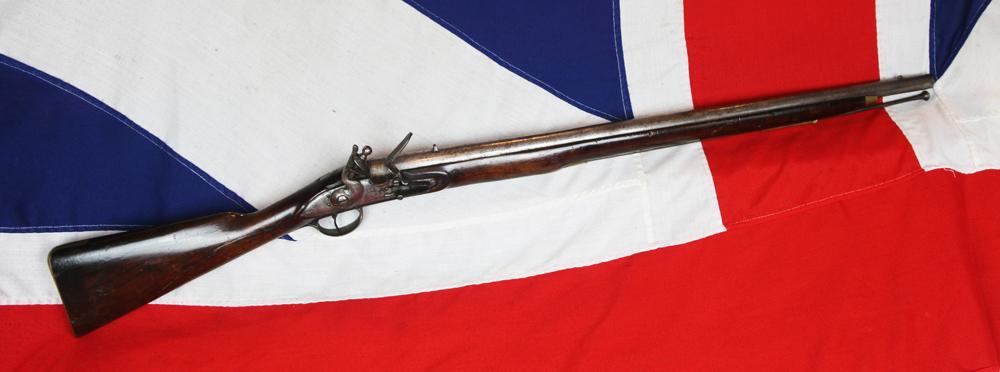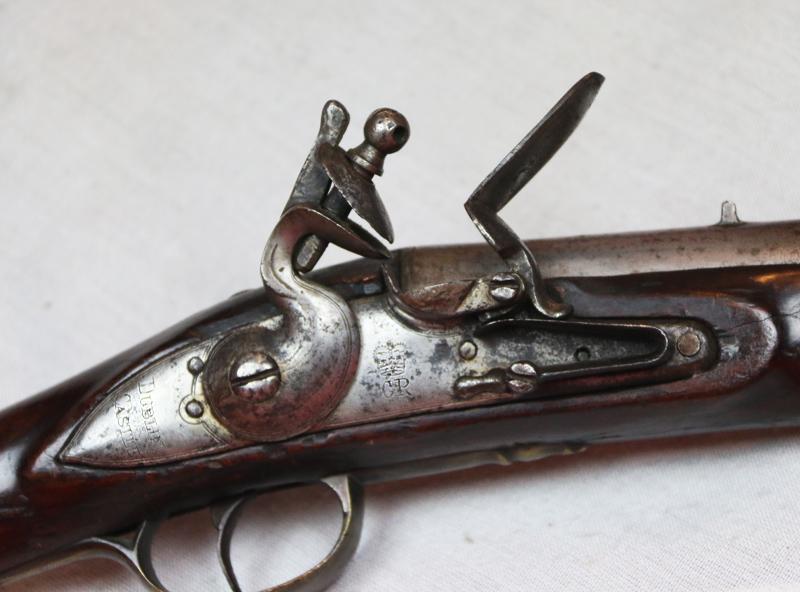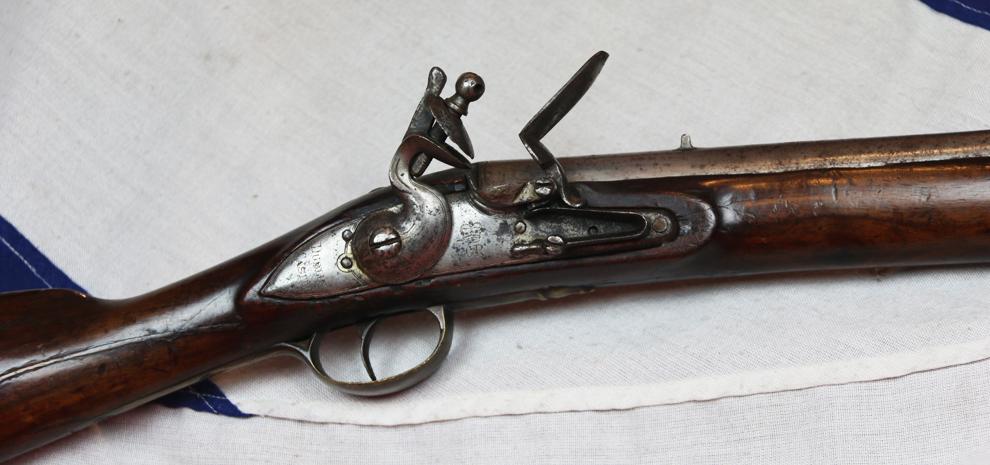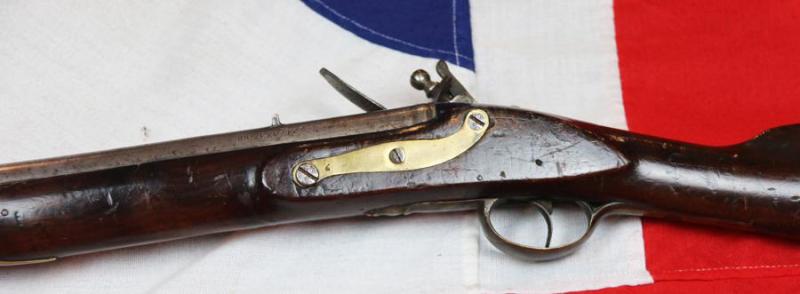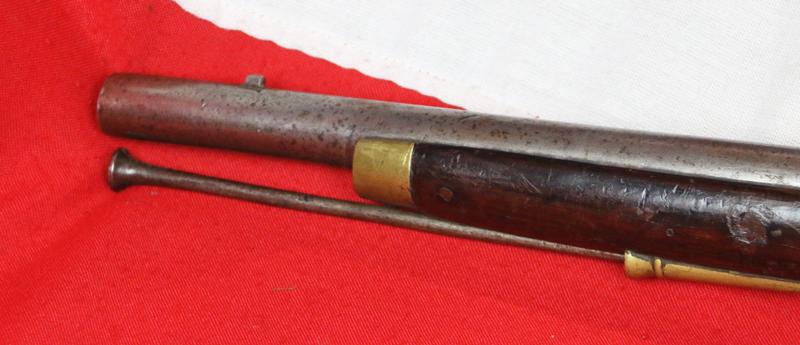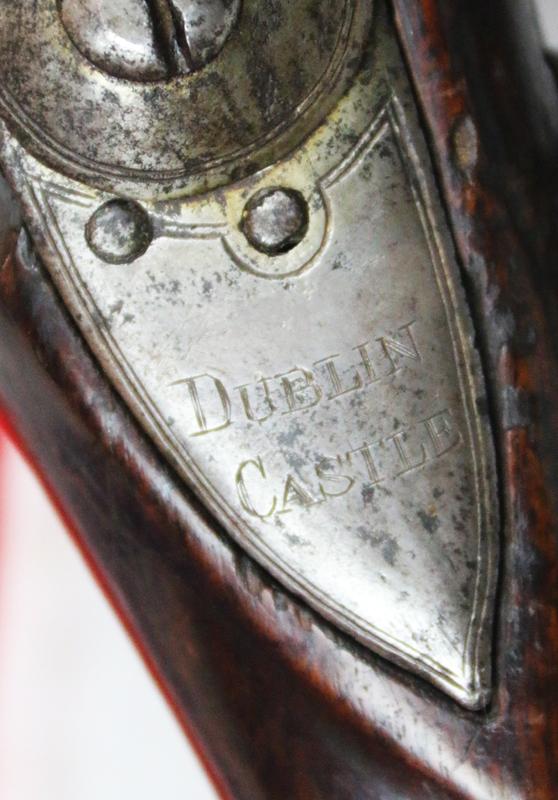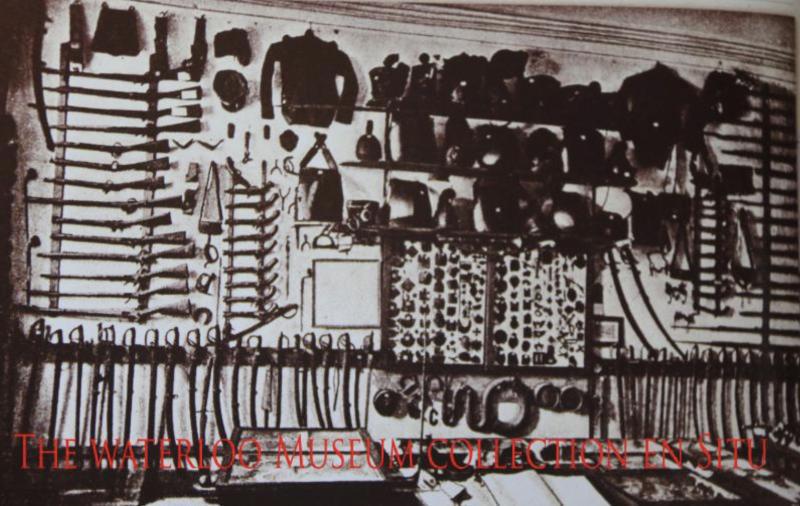A Most Attractive Napoleonic Wars Era, Dublin Castle Flintlock Mounted Sergeant's Length 'Brown Bess' Musket
A mighty and strong King George IIIrd period 'Brown Bess' musket, for it is often known that Dublin Castle assembled muskets frequently had stronger grade stocks than the equivalent Tower of London examples, that were made in London.
It has a good and fine patinated walnut stock, good action, and good traditional third pattern brass furniture, trigger guard. 32" barrel. Often the barrel length of 32-33" were supplied for sergeants of the line within the regiments. Dublin Castle flintlocks are scarce and are now and are very highly prized and esteemed, especially by the collectors of early Irish weaponry.
This is a very inexpensive piece, and an option to own a fine looking 'Brown Bess' musket, at considerably less cost than a more standard regulation issue example.
The story of the Irish regiments under Wellington's command, such as in in the famous and renown 27th Regiment of Foot, the Enniskillen Inniskilling,. It was a descendent entity from one of the Enniskillen militia raised during the War of the Two Kings, which had become an established unit during the many wars of the 18th century. Against France in this round of fighting, the “Inniskilling” regiment fought in Flanders before helping to take islands in the Caribbean, as many Irish regiments did, suffering terribly from the heat and tropical diseases they were soon unsuited to deal with. Later came greater glory, with the regiment taking part in the Battle of Alexandria in 1801 and then the Battle of Maida in Italy, both crucial victories in the respective campaigns. The regiment entered into the Peninsular Wars in dribs and drabs, with its 1st Battalion joining Wellesley nearly everywhere, and the 3rd only arriving in 1813, but the regiment still had the opportunity to inflict heavy casualties on the French enemy at the Battle of Castalla, before suffering the same a few months later at Ordal, one of the last significant French victories of that campaign. In 1815, the regiment took its place at Waterloo. The 27th Foot bore the brunt of Napoleon’s frontal assault and suffered 481 men killed or injured. The course of the French Revolutionary Wars and the subsequent Napoleonic Wars bears little going into. Between 1792 and 1815, France fought numerous conflicts against a series of opposing coalitions. What began as a conflict of mere survival for the Revolution soon morphed into a more imperialistic venture when France fell under the control of Napoleon Bonaparte in 1799: he would eventually lead France to control a huge chunk of Europe, stretching all the way to Moscow in the east and to the Portuguese coastline in the west. But it couldn’t last, with the French state practically dependent on constant expansion to sustain itself, and Napoleon suffered two major falls, the first in 1813 when British, Austrian, Russian and Prussian overran France, and the second in 1815, after the titanic clash at Waterloo. Throughout the entire conflict, Irish troops were heavily involved, in numerous armies, but none more so than the British.The 1st Battalion went on to fight at the Battle of Waterloo as part of John Lambert's 10th Brigade in the 6th Division. At about 6:30 PM, the French captured the key strongpoint of La Haye Sainte farm. After this success, they brought up several cannon and took the Anglo-Allied lines under fire at extremely close range. At this period, the 698-strong battalion was deployed in square at the point where the Ohain road crossed the Charleroi to Brussels highway. At a range of 300 yards (270 m), the French artillery caused the unit enormous casualties within a short time. At day's end, the 1st Battalion had lost 105 killed and 373 wounded, a total of 478 casualties, without breaking. The unit was described as "lying dead in a square". At the time of Waterloo, the soldiers of the 27th were dressed in red, short-tailed jackets, overall trousers, and a high-fronted shako. The facing colour was buff and it was displayed on the collar, cuffs, and shoulder-straps. The lace on the cuffs and jackets had square-ended loops.
The muskets barrel shows where during its later working lifetime it has travelled back with the EIC and thus served in India, and has been struck with their armoury stamps. Due to the vagaries of intense war and the inevitable short supply of arms, often muskets and pistols had to be supplied by the board of ordnance from gun parts in stores, and thus assembled as and when urgency demanded, or guns returned to the ordnance to replace parts damaged in combat, guns of some mixed part types were inevitable. Therefore, typically this musket has a 'Brown Bess' new land style butt plate, and a transitional period {central screw} sideplate. A photo in the gallery shows a photograph of one section of the collection in the museum of Waterloo, taken in around 1900, showing all the weapons used at Waterloo en situ, including all the protagonists {British Brown Bess, French, Prussian and Belgian muskets, swords, pistols, armour uniforms, etc}. The museum was founded and owned by a veteran of the 7th Hussars that fought at Waterloo. Overall the musket very a nice condition and an impressive looking armoury issue composite musket, and with, as to be expected, signs of usual combat use.
Code: 23209
2750.00 GBP

